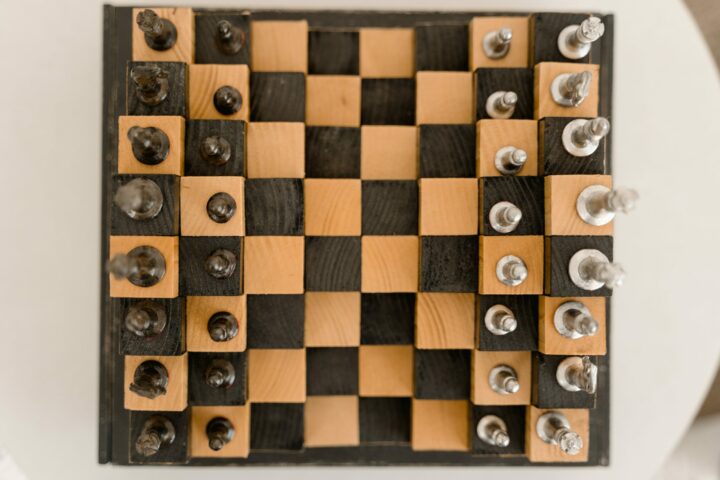Are you ready to take on one of the most formidable opening gambits in the game of chess? The King’s Gambit, a bold and aggressive choice for white, has challenged players for centuries with its potential rewards and inherent risks.
In this article, we will delve into the secrets of countering this strategic opening, equipping you with the knowledge and tactics to confidently navigate the complex battle that unfolds on the chessboard.
What is the King’s Gambit and why is it a force to be reckoned with?
The King’s Gambit is a daring and aggressive opening in chess that has captivated players throughout history. It starts with white sacrificing a pawn to rapidly develop their pieces and launch an attack against black’s king. This gambit creates an immediate imbalance on the board, putting pressure on black to defend and respond accurately.
The King’s Gambit is a force to be reckoned with because it demands precise calculation and strategic thinking from both players. The element of surprise and the potential to seize the initiative make it a formidable weapon in the hands of skilled practitioners.
How can I exploit the weaknesses in the King’s Gambit?
When facing the King’s Gambit, it’s crucial to recognize and exploit the weaknesses it presents. The sacrificed pawn in the center can leave white’s position vulnerable, providing opportunities for black to counterattack and regain the material advantage.
By carefully analyzing the pawn structure and piece activity, black can identify weak squares and lines to target, exploiting white’s positional vulnerabilities. Understanding the intricacies of piece coordination and exploiting positional imbalances will allow black to effectively navigate the complexities of the King’s Gambit and gain the upper hand in the ensuing battle.
What are the key principles for black when facing the King’s Gambit?

For black, the key principles when facing the King’s Gambit revolve around solidifying the defense and minimizing white’s attacking chances. Maintaining a strong central presence and prioritizing piece development are essential.
Black should aim to establish a solid pawn structure, ensuring that the king remains safe and well-protected. Creating counterplay opportunities and seeking tactical chances are also important principles to remember. By adhering to these key principles, black can effectively neutralize white’s aggressive intentions and shift the momentum of the game in their favor.
Which defensive setups work best against the King’s Gambit?
To effectively defend against the King’s Gambit, several defensive setups have proven successful. One popular defensive option is the Falkbeer Counter Gambit, where black accepts the gambit pawn and counterattacks in the center to disrupt white’s plans. Another defensive approach is the Classical Defense, focusing on developing the pieces harmoniously and reinforcing the central control.
Additionally, the Modern Defense offers flexibility and dynamic play, allowing black to exploit white’s weaknesses and launch their own strategic counterattacks. These defensive setups provide black with solid foundations to withstand the onslaught of the King’s Gambit and pose challenges to white’s ambitions.
How can I turn the tables and launch a counterattack in response?
When facing the King’s Gambit, black has the opportunity to turn the tables and launch a potent counterattack. By carefully coordinating their pieces and exploiting weaknesses in white’s position, black can seize the initiative and put white on the defensive.
Timing is crucial, and a well-timed counterstrike can catch white off guard, forcing them to divert attention from their attacking ambitions. Employing tactical combinations, exploiting open lines, and creating threats against white’s king are effective strategies for launching a successful counterattack and potentially turning the tide of the game in black’s favor.
What are the crucial pawn structures to consider in the King’s Gambit?
Understanding the pawn structures that arise from the King’s Gambit is vital for both white and black. The central pawns and their subsequent exchanges greatly influence the character of the position and the strategic plans for each side. The Falkbeer Countergambit, for instance, can result in an asymmetrical pawn structure that creates imbalances and tactical opportunities.
Recognizing the strengths and weaknesses of various pawn structures will allow players to make informed decisions and leverage them to their advantage. Carefully considering the pawn structures and their implications is a critical aspect of successfully navigating the complexities of the King’s Gambit.
What are the main lines and variations of the King’s Gambit?
The King’s Gambit offers a rich tapestry of main lines and variations, each with its own unique strategic and tactical considerations. The Bishop’s Gambit, for example, features an early fianchetto of the kingside bishop, while the Muzio Gambit introduces a daring sacrifice of a knight to launch a ferocious attack.
The Cunningham Defense, the Allgaier Gambit, and the Falkbeer Countergambit are among the other notable lines in the King’s Gambit repertoire. Exploring and understanding these main lines and variations will provide players with a diverse range of options to both employ and counter the King’s Gambit, further enriching their chess experience.
What are the most common mistakes players make when playing against the King’s Gambit?
When playing against the King’s Gambit, it’s important to be aware of the most common mistakes that players tend to make. One common mistake is succumbing to the temptation of greedily holding onto the extra pawn, neglecting development and exposing their king to potential attacks.
Another mistake is underestimating the power of counterplay, failing to seize opportunities to strike back and regain the initiative. Additionally, neglecting proper piece coordination and failing to reinforce weaknesses in the opponent’s position can lead to missed chances. By avoiding these common pitfalls, players can navigate the complexities of the King’s Gambit more effectively and increase their chances of success.
Are there any famous chess games featuring the King’s Gambit?
Throughout the history of chess, numerous famous games have featured the King’s Gambit, captivating chess enthusiasts around the world. One such game is the legendary encounter between Adolf Anderssen and Lionel Kieseritzky, known as “The Immortal Game.”
In this game, Anderssen sacrificed multiple pieces, including the queen, to launch a devastating attack against Kieseritzky’s king. The game is renowned for its brilliant sacrifices and combinations, showcasing the dynamic nature of the King’s Gambit. Exploring these famous games allows players to witness the creative possibilities and tactical brilliance that can arise from this exciting opening.
How can I prepare my opening repertoire to handle the King’s Gambit?

To prepare your opening repertoire to handle the King’s Gambit effectively, it’s essential to study and analyze the key variations and lines of this aggressive opening. Familiarize yourself with different defensive setups, such as the Falkbeer Counter Gambit, Classical Defense, or Modern Defense, to find the approach that suits your style of play.
Study annotated games and gain insights from experienced players to understand the strategic ideas and typical pawn structures that arise from the King’s Gambit. By honing your knowledge and preparing specific responses, you can approach the King’s Gambit with confidence and navigate the opening successfully.
What are the alternative strategies to neutralize the King’s Gambit’s aggressive nature?
While the King’s Gambit is renowned for its aggressive nature, there are alternative strategies that can be employed to neutralize its potential threats. One approach is to opt for solid and positionally sound setups, aiming to defuse white’s attacking ambitions and gradually outplay the opponent in the middlegame.
Another strategy is to focus on piece development and central control, denying white the opportunity to launch a devastating attack. By shifting the game to a quieter and more maneuvering style, players can undermine the aggressive intentions of the King’s Gambit and capitalize on their opponents’ overextension.
How do grandmasters approach the King’s Gambit?
Grandmasters approach the King’s Gambit with a deep understanding of its nuances and a wealth of experience. They carefully balance aggression with caution, evaluating the risks and rewards of each move.
Grandmasters often rely on precise calculation, tactical acumen, and strategic maneuvering to exploit weaknesses in their opponent’s position. By studying their games and observing their decision-making process, aspiring players can learn valuable lessons in calculating sacrifices, coordinating pieces, and effectively responding to the challenges posed by the King’s Gambit.
What are the psychological aspects to consider when facing the King’s Gambit?
When facing the King’s Gambit, it’s essential to consider the psychological aspects of the game. The aggressive nature of the opening can create a tense and unpredictable atmosphere, requiring players to stay calm and focused.
It’s crucial to resist the temptation to play passively out of fear and instead seek opportunities to counterattack and apply pressure on the opponent.
Maintaining confidence, adaptability, and resilience are key psychological factors that can influence the outcome of the game. By understanding and managing these psychological aspects, players can navigate the complexities of the King’s Gambit with a clear mind and a strategic approach.
How can I use tactics and positional play to gain an advantage against the King’s Gambit?

To gain an advantage against the King’s Gambit, tactics and positional play are indispensable tools. Look for tactical opportunities, such as forks, pins, and discovered attacks, that can exploit weaknesses in your opponent’s position.
Calculating accurately and spotting tactical motifs can help you seize the initiative and create winning chances. Additionally, pay attention to positional considerations, such as pawn structure and piece activity. By establishing a solid pawn structure and coordinating your pieces effectively, you can gain a lasting advantage and control the flow of the game against the King’s Gambit.
Is it possible to completely refute the King’s Gambit?
| Aspect | Advantages | Considerations |
|---|---|---|
| Defensive Setups |
|
|
| Alternative Strategies |
|
|
| Grandmaster Approach |
|
|
| Psychological Aspects |
|
|
| Tactics and Positional Play |
|
|
While it is difficult to completely refute the King’s Gambit, it is possible to neutralize its aggressive ambitions and minimize its effectiveness. By employing solid defensive setups, counterattacking at the right moment, and maintaining accurate calculation, players can withstand white’s aggressive intentions and navigate the complications of the opening successfully.
It’s important to remember that chess is a game of constant evaluation and adaptation, and there is no guaranteed refutation for every move. By staying flexible, exploiting weaknesses, and employing sound positional principles, players can navigate the challenges of the King’s Gambit and emerge with a favorable outcome.
Wrap-up
In conclusion, the King’s Gambit in chess is a captivating and dynamic opening that demands both strategic foresight and tactical precision. By understanding its intricacies, players can navigate the challenges posed by this aggressive gambit and seize opportunities for counterplay.
Through the exploration of key principles, defensive setups, alternative strategies, and the wisdom of grandmasters, players can develop a comprehensive approach to handling the King’s Gambit. Psychological considerations, tactical acumen, and positional play also play crucial roles in gaining an advantage against this formidable opening.
While the King’s Gambit remains a force to be reckoned with, with careful preparation and strategic decision-making, players can face it with confidence, skillfully outmaneuver their opponents, and emerge victorious in the royal battle of chess.




